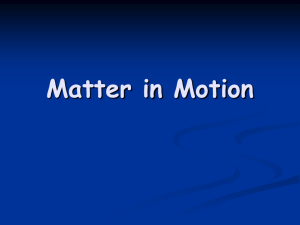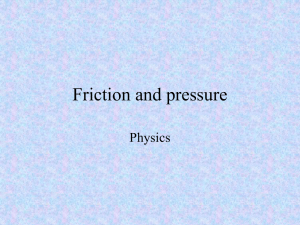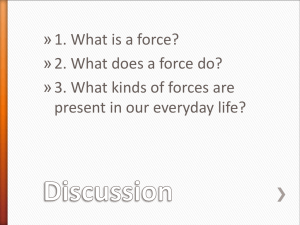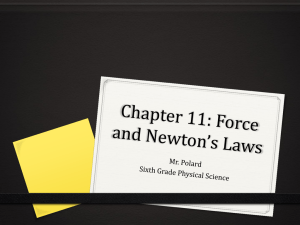Normal Force
advertisement
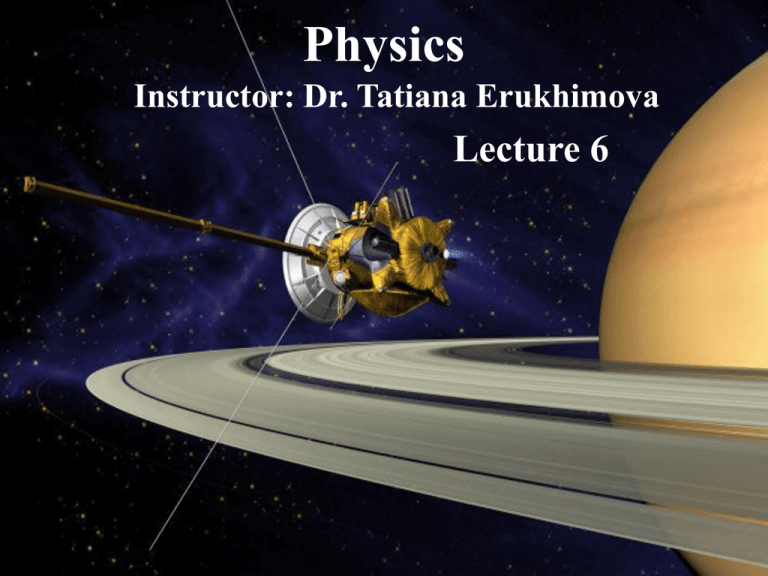
Physics Instructor: Dr. Tatiana Erukhimova Lecture 6 Balance of Forces and Torques Concept of Center of Mass r Fext 0 r r r F r or r ext 0 r F Map of Texas r F 0 Because r 0 F mg r F 0 r r F mg r F 0 Because r 0 F mg Brady, TX Skyhooks The skyhook alone won’t balance on your finger, but when you put a belt on it, it does! This is all because adding the belt which curves under as it hangs actually moves the center of mass right under your finger! Newton’s Laws 1st Law: A body acted on by no net force moves with constant velocity (which may be zero) and zero acceleration 2nd Law: The acceleration of an object is directly proportional to the net force acting on it and is inversely proportional to its mass. The direction of the acceleration is in the direction of the net force acting on the object. 3rd Law: For every action there is an equal, but opposite reaction Aristotle: a natural state of an object is at rest; a force is necessary to keep an object in motion. It follows from common sense. 384-322 B.C. Galileo: was able to identify a hidden force of friction behind commonsense experiments 1564-1642 Galileo: If no force is applied to a moving object, it will continue to move with constant speed in a straight line Inertial reference frames Galilean principle of relativity: Laws of physics (and everything in the Universe) look the same for all observers who move with a constant velocity with respect to each other. Newton’s rd 3 Law For every action there is an equal, but opposite, reaction 2nd Law From experiments we know: 1.Force is a vector 2.The direction of acceleration vector is the same as the direction of the force vector 3.The magnitude of the force and acceleration are related by a constant which depends on number of blocks involved. Newton’s second law F ma The vector acceleration of an object is in the same direction as the vector force applied to the object and the magnitudes are related by a constant called the mass of the object. A Recipe for Solving Problems 1. Sketch Isolate the body (only external forces but not forces that one part of the object exert on another part) 2. Write down 2nd Newton’s law F ma Choose a coordinate system Write 2nd Newton’s law in component form: F Fx i Fy j m ax i m ay j Fx m ax , Fy m ay 3. Solve for acceleration Newton’s 2nd Law F ma Fx max Fy may Newton’s 3rd Law N N Gravitational force F mg Normal force (perpendicular to the surface) P P No friction m1 m1 m2 Free body diagram N1 F12 F21 m1 N2 m2 m2g m1g F12=F21 No friction: =0 H What is the normal force? Coefficient of friction: H What is the normal force? Friction Two types of friction: 1. Kinetic: The friction force that slows things down 2. Static: The force that makes it hard to even get things moving Kinetic Friction • For kinetic friction, it turns out that the larger the Normal Force the larger the friction. We can write FFriction = KineticN Here is a constant • Warning: – THIS IS NOT A VECTOR EQUATION! Static Friction • This is more complicated • For static friction, the friction force can vary FFriction StaticN Example of the refrigerator: – If I don’t push, what is the static friction force? – What if I push a little? There is some maximum value the friction force can achieve, and once we apply a force greater than this maximum there is a net force on the object, so it accelerates. The maximum of the force of friction varied linearly with the amount that the block pushes on the table. F friction N - coefficient of friction, N is the vertical force exerted by the block on the table The friction force only exists when there is another force trying to move an object Coefficient of friction: Mass m H What is the normal force? What is the acceleration of the block? Is it better to push or pull a sled? You can pull or push a sled with the same force magnitude, FP, and angle Q, as shown in the figures. Assuming the sled doesn’t leave the ground and has a constant coefficient of friction, , which is better? FP FP Pulling Against Friction A box of mass m is on a surface with coefficient of kinetic friction . You pull with constant force FP at angle Q. The box does not leave the surface and moves to the right. What is the magnitude of the acceleration? Q Hockey Puck • Which of these three best represents a hockey puck in the real world? a) b) c) A small block, mass 2kg, rests on top of a larger block, mass 20 kg. The coefficient of friction between the blocks is 0.25. If the larger block is on a frictionless table, what is the largest horizontal force that can be applied to it without the small block slipping? F N1 N2 N1 N1 F N1 m1 g m2 g V0 A block of mass m is given an initial velocity V0 up an inclined plane with angle of incline θ. Find acceleration of the block if a) = 0 b) non-zero A block of mass 20 kg is pushed against a vertical surface as shown. The coefficient of friction between the surface and the block is μ = 0.2. If θ = 300, what is the minimum magnitude of P to hold the block still? P A Problem With First Year Physics Strings and Pulleys m1 m1, m2 are given m2>m1 String is massless and unstretchable m2 Find accelerations of m1 and m2 (assume no friction) A wedge with mass M rests on a frictionless horizontal tabletop. A block with mass m is placed on the wedge and a horizontal force F is applied to the wedge. What must the magnitude of F be if the block is to remain at a constant height above the tabletop? F

